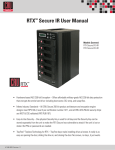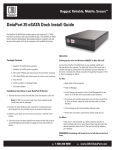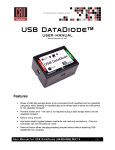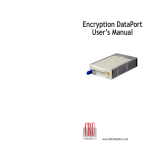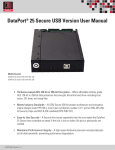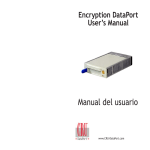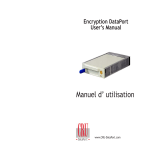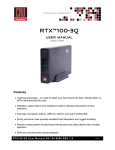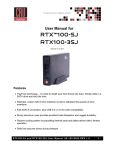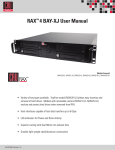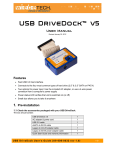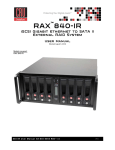Download DataPort® 10 Secure User Manual
Transcript
DataPort® 10 Secure User Manual Models Covered: DataPort 10 Secure with AES 128 DataPort 10 Secure with AES 256 • Hardware-based AES 128-bit or 256-bit Encryption - Offers affordable military-grade AES 128bit or 256-bit data protection that encrypts the entire hard drive - including boot sector, OS, temp, and swap • Meets Industry Standards - All CRU Secure 256-bit product architecture and encryption engine designs meet FIPS140-2, level 3 per number 1471, and all CRU AES 256bit security chips are NIST & CSE validated (FIPS PUB 197). • No Key Management - The encryption key is mounted to the back of the frame. Simply remove the carrier and the hard drive is encrypted. • DataPort 10 Design - A rugged metal design that incorporates a patented temperature controlled cooling system for ultimate data protection. A6-010-0002 Revision: 3.3 1. Pre-Installation Steps Table of Contents 1. Pre-Installation Steps 1 1.1 Box Contents 1 1.2 Identifying Parts of your DataPort 10 Secure 1 1.3 Warnings and Notices 2 2. Installation Steps 1.1 Box Contents The following list contains the items that are included in the complete for this device. Depending on which and accessories you purchased, the package may include fewer items than what are listed here. Please contact CRUDataPort if any items are missing or damaged: 2 2.1 Receiving Frame Installation 2 2.2 Hard Drive Installation 2 2.3 Operating the DataPort 10 Secure 2 2.4 Safe Carrier Removal 2 DataPort 10 Frame 1 2.5 Other 3 DataPort 10 Carrier 1 Options 2.5.1 Fan Failure Alarm Accessories 3 3. Usage with Mac and Windows Operating Systems 3 4. Encryption 4 5. Frequently Asked Questions Quantity 5 M3 x 5 pan head frame mounting screws 4 4 Molex-to-SATA Adapter Cable 1 5 DataPort Keys 2 Security Keys 3 Lanyards for Security Keys 3 Security Key ID Tag 3 Security Key Labels 6 1.2 Identifying Parts of Your DataPort 10 Secure Key Lock Mini-USB Security Key Port Carrier Handle Page 1 frame. If no SATA power connectors are available, attach the included Molex-to-SATA adapter cable to a Molex power plug. Then plug the SATA end of the adapter cable into the rear of the receiving frame. 2.2 Hard Drive Installation Security Key Error LED Encryption Enabled LED Activity LED Power LED 1.3 Warnings and Notices Please read the following before beginning installation. • • • • • The main circuit board of the HDD carrier is susceptible to static electricity. Proper grounding is strongly recommended to prevent electrical damage to the enclosure or other connected devices, including the computer host. Avoid all dramatic movement, vibration and percussion. Avoid placing the HDD carrier close to magnetic devices, high voltage devices, or near a heat source, including any place where the product will be subject to direct sunlight. Do NOT allow water to make contact with any Security Keys, carrier or receiving frame. Though the Security Key port is mechanically identical to the standard Mini-USB port, inserting Security Keys into any other Mini-USB port will damage the keys and render them useless. Please only use Security Keys in DataPort Secure products. Likewise, inserting a Mini-USB cable or other device into the DataPort 10 Secure Security Key port on the carrier can cause internal damage and potentially lead to loss of data. Any time power is cycled on the DataPort 10 Secure, the encryption key will need to be installed in order to access the data on the drive. 2. Installation Steps 2.1 Receiving Frame Installation a. Slide the receiving frame into an open 5.25” bay. b. Secure the receiving frame to the chassis with the four screws provided. c. Attach the SATA data cable to the rear of the receiving frame and the other end to the corresponding SATA port on the computer’s motherboard. d. Attach the SATA power connectors to the rear of the receiving a. If the carrier is bundled with a frame, use the included set of DataPort Keys to unlock the carrier and then remove it from the frame. b. Use a Phillips-head screwdriver to remove the screw securing the carrier cover to the back of the carrier, then slide the cover off. c. Insert a SATA hard drive into the nector inside the carrier. power and data con- d. Secure the hard drive to the carrier by using the mounting screws provided. e. Attach the Temperature Control Cooling Sensor to the top of the hard drive with a piece of tape. f. Replace the cover and secure it with the screw you removed in Step B. into the rear of the carrier. g. Reinsert the carrier into the frame. 2.3 Operating your DataPort 10 Secure a. If you have not already done so, slide the DataPort 10 Secure carrier into an open DataPort 10 frame (may be sold separately) on your computer. b. Insert the Security Key into the Mini-USB Security Key Port on the face of the receiving frame. c. Insert a DataPort Key into the key lock and turn it 90 degrees clockwise to power on the unit. d. When both green LEDs are lit, showing that the drive is ready and encryption is activated, remove the Security Key and store it in a safe location. When any hard drive is used with the DataPort 10 Secure it will show up as a blank, unallocated drive and you’ll need to format the drive inside the enclosure before you can use it. Note that formatting a drive will erase all data on the drive, so be sure to back up your data before beginning this operation. See Section 3 for instructions on how to format the drive with Mac or Windows operating systems. 2.4 Safe Carrier Removal a. Turn off the computer or properly dismount the drive from Page 2 the system. See Section 3 for instructions on how to properly dismount the drive from Mac or Windows systems. b. Use the DataPort Key to turn the keylock 90 degrees counterclockwise to unlock and power off the unit. c. Pull the carrier by the handle towards you to remove the carrier. 2.5 Optional Configuration Settings 2.5.1 Fan Failure Alarm 3.1.3 Mounting and Unmounting Volumes The fan failure alarm function is a standard feature on the DataPort 10. If the cooling fan should fail, an alarm will beep and the green LED on the upper left corner of the DataPort will flash indicating fan failure. Remove the jumper on JP6 on the frame (see picture) to silence the audible alarm. The jumper is located directly below the fan power connector on the DataPort 10 Secure circuit board. If the hard drive installed in the DataPort 10 Secure was previously formatted with the correct Security Key inserted into the Mini-USB Security Key Port on the face of the receiving frame, then you can begin using the volume right away. If the drive is unformatted, a message will appear on the desktop saying that the disk is unreadable. You can use OS X’s Disk Utility to easily format the drive (see section above). Jumper 3. Usage with Mac and Windows Operating Systems 3.1 Usage with Mac OS X 3.1.1 Compatibility The DataPort 10 Secure supports 2.5” and 3.5” SATA hard drives. 3.1.2 Formatting a Drive To format, use Mac OS X’s Disk Utility (found in the applications folder). The DataPort 10 Secure must have been powered on with the Security Key present and both the Power and Encryption Ready LEDs must be lit. See Section 2.3 for instructions on how to do so. a. Click on the drive in the window to the left (see picture to right). b. Click the Erase tab in the window to the right (see picture to right). c. Select the format type. Most users prefer Mac OS Extended with Journaling (HFS+), which is required for compatibility with Time Machine (OS 10.5 or newer). If you need to use your DataPort 10 Secure with both Mac and Windows computers, select MS-DOS File System instead. d. Enter a name for the new volume and then click “Erase” to start the process. Unmount the volume before powering down the unit by dragging the volume’s icon to the trash bin, or by selecting the volume then pressing Command-E. Disconnecting the unit without first unmounting the volume can result in data loss (see picture to the right). 3.1.4 Creating a Boot Drive To activate this feature, you must first install OS X on the hard drive in your carrier. The easiest way to do this is to clone an existing system drive using a utility such as Carbon Copy Cloner or Super Duper. Next, go to System Preferences --> Startup Disk. A window will list the available bootable volumes. Select the volume from which you wish to boot. Another method is to hold down the Option key during boot up. A screen should appear that allows you to select the volume you wish to use. This is useful if you wish to boot from your DataPort 10 Secure hard drive only some of the time. 3.2 Usage with Windows Operating Systems 3.2.1 Compatibility The DataPort 10 Secure supports 2.5” and 3.5” SATA hard drives. 3.2.2 Formatting a Drive To format, use the Disk Management utility. The DataPort 10 Secure must have been powered on with the Security Key present and both the Power and Encryption Ready LEDs must be lit. See Section 2.3 for instructions on how to do so. a. Right-click on My Computer, then select Manage. The Computer Management window will open. Page 3 b. In the left pane of this window, left-click on Disk Management. c. The drive should appear in the list of Disks in the lower middle/ right pane (see picture below). You may need to scroll down to see it. If the drive is already formatted, you can identify it easily by its volume name. If it’s unformatted, the Drive Properties Box will say “Unallocated” and you’ll need to initialize the disk before formatting it. Initialize the disk by right-clicking the Device Properties Box and selecting Initialize Disk. DataPort 10 Secure is properly connected and turned on, a window may open to allow you access to the volume. If no window appears, you can find the volume by double-clicking the “My Computer” icon. Unmount the DataPort 10 Secure before powering it down by singleclicking the green arrow icon on the task bar (in Windows XP) or the USB plug icon with the green checkmark on the taskbar (Windows Vista and Windows 7), then selecting “Safely remove….” Windows will indicate when it is safe to disconnect the DataPort 10 Secure. Disconnecting the unit without first ejecting it can result in data loss. 4. Encryption • T he DataPort 10 Secure uses full disk hardware encryption to encrypt the entire contents of the drive - including the boot sector, operating system and all files - without performance degradation. d. To format the drive, right-click the Drive Properties Box and select Format. e. If you are prompted to select a partition type, select MBR for NOTE: Windows XP does not support GPT or volumes larger than 2TB. volumes 2TB or smaller, or GPT for volumes larger than 2TB. f. Click through several more windows, leaving the default settings, until you see a window that allows selection of a file system. Choose NTFS and enter a name for the new volume. Be sure to check the box labeled “Perform a quick format” unless you want to completely erase any data on the drive and have time to wait. A quick format should take less than a minute, while standard formatting may take several hours. g. Click “Next” and then “Finish” to start the format process. When the format is complete, the Drive Properties Box will update to show the new volume name. The new volume can now be found in My Computer. 3.2.3 Mounting and Unmounting Volumes If the hard drive installed in the DataPort 10 Secure was previously formatted with the correct Security Key inserted into the Mini-USB Security Key Port on the face of the receiving frame, then when the • The encryption key must be installed prior to powering on the DataPort 10 Secure for the data to be decrypted on the drive. If the key is externally connected to the Mini-USB Security Key Port and is not internally installed, then once it has been accepted, it may be removed and stored apart from the data so that in the event that the drive is lost or stolen, the data is protected. • When a drive is formatted using an encryption key, the same or a duplicate key must be used in order to access the data. There is no “back door” to access the data; lost keys make data recovery virtually impossible. 5. Frequently Asked Questions (FAQ) Q: What do the LED lights indicate? # LED Name Color State A: 1 Drive Activity Amber 2 Power Green 3 Key Error 4 Encryption Flashes when Intermittent the drive is being accessed. Solid Unit is powered on. Flashing Fan Failure. Solid Encryption engine error. Contact Technical Support. Flashing The Security Key is not present or is not functioning. Solid The Security Key is present and encryption is enabled. Red Green Description Page 4 Q: Why can’t I access my data when I turn on my unit? A: If you have data on the drive, don’t panic! Barring the failure of the hard drive your data is still intact, but is not reachable because the drive was not formatted within this unit using the correct Security Key. If you previously formatted the drive using a Security Key, power off the unit and insert the correct Security Key into the MiniUSB Security Key port on the front of the carrier. Then turn your unit back on. When both green LEDs are lit, showing that the drive is ready and encrypted, you should then be able to access your data. You can then remove the Security Key and store it in a safe location. Q: C an I use my 128-bit encrypted hard drive in a 256-bit enclosure, or a 256-bit encrypted hard drive in a 128-bit enclosure? A: No. 128-bit and 256-bit encryption are not cross-compatible. Contacting Technical Support Still need help? Please contact our Technical Support team through CRU-DataPort.com. Or call us toll free at (800) 260-9800, or directly at (360) 816-1772. If you did not format the drive using a Security Key, you will need to make a backup copy of your data and format the drive using the correct Security Key. See Section 3 for instructions on how to format the drive with Mac or Windows operating systems. Q: I turned my unit off and back on and now I cannot access my data. Why? A: Cycling power on the unit will require you to reinsert the Security Key into the Mini-USB Security Key port before turning the unit back on, even if you have not turned your computer off. If the unit is on, power it off and insert the correct Security Key into the Mini-USB Security Key port on the front of the carrier. Then turn your unit back on. When both green LEDs are lit, showing that the drive is ready and encrypted, you should then be able to access your data. You can then remove the Security Key and store it in a safe location. Q: W hy can’t I use another device through the Mini-USB port on the front of the DataPort 10 Secure carrier? A: T his port is used by the Security Key to provide the encryption key to the unit hardware that will allow the unit to access the data on your hard drive. It does not pass data to the drive itself. Under no circumstances should you insert anything other than a Security Key into the Mini-USB Security Key Port. Though it is mechanically identical to the standard Mini-USB port, inserting a Mini-USB cable or other device into the MiniUSB Security Key Port on the carrier can cause internal damage and potentially lead to loss of data. Likewise, inserting the Security Keys into any other Mini-USB port will damage the keys and render them useless. Please only use the Security Keys in DataPort Secure products. If you have already tried to use another device through this port or have inserted the Security Key into another device’s Mini-USB port, first check to see if your Security Key still works in your DataPort 10. If it does not, please contact Technical Support. Page 5 Contacting Technical Support Still need help? Please contact our Technical Support team through CRU-DataPort.com. Or call us toll free at (800) 260-9800, or directly at (360) 816-1772. 6. Technical Specifications Product Warranty Product Name DataPort 10 Secure with Internal Key Interface Types & Speeds SATA: up to 150 Mbps Compatibility • 2.5” SATA Hard Drives • 3.5” SATA Hard Drives Data Connectors One (1) eSATA connector Encryption 128-bit AES (Advanced Encryption Standard) or 256-bit AES 128-bit and 256-bit encryption are not cross-compatible Connector Insertion Rating 25,000+ Carrier-to-Frame Operating System Requirements • Windows 7, Vista, or XP • Mac OS X • Linux distributions that support SATA, USB, or FireWire 800 Compliance EMI Standard: FCC Part 15 Class B, CE EMC Standard: EN55022, EN55024 FIPS: FIPS 140-2, FIPS PUB 197 Shipping Weights 3.00 pounds (includes accessories) Dimensions 5.75” x 7.87” x 1.61” (146mm x 200mm x 41mm) Warranty 3-year limited warranty. See warranty statement for details and limitations. We don’t want anything to go wrong with your CRU-DataPort product. But if it does, Tech Support is standing by and ready to help. Contact us at http://www.cru-dataport.com/technicalsupport/customer-technical-support.php CRU-DataPort (CRU) warrants this product to be free of significant defects in material and workmanship for a period of three years from the original date of purchase. CRU’s warranty is nontransferable and is limited to the original purchaser. Limitation of Liability The warranties set forth in this agreement replace all other warranties. CRU expressly disclaims all other warranties, including but not limited to, the implied warranties of merchantability and fitness for a particular purpose and noninfringement of third-party rights with respect to the documentation and hardware. No CRU dealer, agent, or employee is authorized to make any modification, extension, or addition to this warranty. In no event will CRU or its suppliers be liable for any costs of procurement of substitute products or services, lost profits, loss of information or data, computer malfunction, or any other special, indirect, consequential, or incidental damages arising in any way out of the sale of, use of, or inability to use any CRU product or service, even if CRU has been advised of the possibility of such damages. In no case shall CRU’s liability exceed the actual money paid for the products at issue. CRU reserves the right to make modifications and additions to this product without notice or taking on additional liability. FCC Compliance Statement: “This device complies with Part 15 of the FCC rules. Operation is subject to the following two conditions: (1) This device may not cause harmful interference, and (2) this device must accept any interference received, including interference that may cause undesired operation.” This equipment has been tested and found to comply with the limits for a Class B digital device, pursuant to Part 15 of the FCC Rules. These limits are designed to provide reasonable protection against harmful interference when the equipment is operated in a home or commercial environment. This equipment generates, uses, and can radiate radio frequency energy and, if not installed and used in accordance with the instruction manual, may cause harmful interference to radio communications. In the event that you experience Radio Frequency Interference, you should take the following steps to resolve the problem: 1) Ensure that the case of your attached drive is grounded. 2) Use a data cable with RFI reducing ferrites on each end. 3) Use a power supply with an RFI reducing ferrite approximately 5 inches from the DC plug. FOR HOME OR OFFICE USE 4) Reorient or relocate the receiving antenna.








